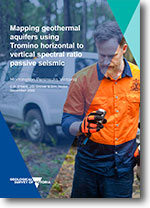Mapping geothermal aquifers using Tromino horizontal to vertical spectral ratio passive seismic. Mornington Peninsula, Victoria.
 |
| |||||
Product description:Executive SummaryDirect-use geothermal energy has the potential to replace existing energy resources in a range of heating applications. These include stand-alone projects such as the heating of swimming pools, aquaculture ponds, greenhouses, buildings, and industrial processes. The technology utilises naturally warm groundwater found in geothermal aquifers. However, the depth and location of geothermal aquifers are poorly understood, and these factors represent a risk for geothermal explorers. Exploration methods, such as drilling and traditional seismic surveys, are generally too expensive for the direct-use geothermal industry. This study combines the use of freely available Bouguer gravity imagery and inexpensive passive seismic data to indicate the depth to geothermal aquifers. A geothermal aquifer was identified by the Geological Survey of Victoria in the Nepean-38 borehole on the Mornington Peninsula. The aquifer is comprised of porous Cenozoic sediments of the Eastern View Group interbedded with basalts of the Older Volcanics. At Nepean-38 the depth to the Eastern View Group is 509 metres, the Older Volcanics are at 645 metres and the Palaeozoic basement is at 754 metres. This aquifer was subsequently developed as a heat source by Peninsula Hot Springs, a commercial tourism operation. The initial discovery at Nepean-38 and the geothermal development at Peninsula Hot Springs are approximately two kilometres apart but the size of the geothermal fairway was previously unknown. New insights from this study suggest the geothermal fairway may be 10 km wide, running north-south along the peninsula as indicated by results obtained between the town of Rosebud and the Nepean-38 borehole. In this study, regional ground-based gravity images were interpreted to identify major basin structures, specifically, the locations of two major basin forming faults. The north-south trending faults form the eastern margin of the Port Phillip Basin and a platform which runs along the eastern margin of the basin. A passive seismic transect was collected between Nepean-38 and Rosebud to provide a vertical profile of subsurface stratigraphy. This seismic transect revealed the depth to the Older Volcanics, a proxy for the aquifer, between 645 and 733 metres across the study area. The results suggest that the depth to the geothermal aquifer and the thickness of the overlying insulating sedimentary sequence are relatively constant through this transect. Passive seismic data could be used to improve understanding of depth to the Older Volcanics throughout the proposed geothermal fairway within the Port Philip Basin. This new technique of constraining gravity data with passive seismic will allow potential proponents to reduce risk in exploring for geothermal energy on the Mornington Peninsula. Bibliographic Reference O'Neill, C.D., Grover, J.D. & Taylor, D.H., 2022. Mapping geothermal aquifers using Tromino horizontal to vertical spectral ratio passive seismic. Mornington Peninsula, Victoria. Geological Survey of Victoria, Department of Jobs, Precincts and Regions, Melbourne, Victoria, 20 pp. Download: The downloadable version of this report is supplied in PDF format (9 MB). | ||||||

